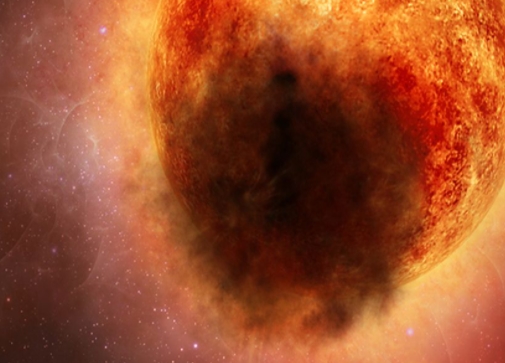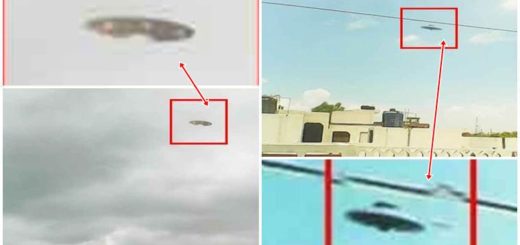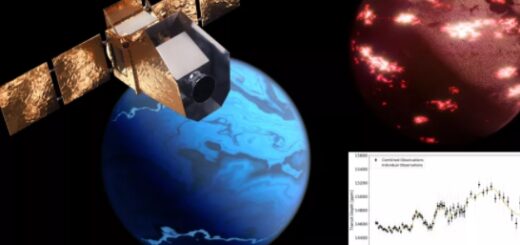The bizarre dimming of bright star Betelgeuse caused by giant stellar eruption

Betelgeuse’s odd recent dimming was caused by a huge cloud of material that the supergiant star blasted into space, a new study suggests.
The bright star Betelgeuse, which forms the shoulder of the constellation Orion (The Hunter), is about 11 times more massive than the sun but 900 times more voluminous. That bloated condition shows that Betelgeuse is near death, which will come in the form of a violent supernova explosion.
In the fall of 2019, Betelgeuse began dimming significantly, losing about two-thirds of its brightness by February. This dramatic dip spurred speculation that the star’s demise may have been imminent — perhaps just weeks away. (From our perspective, anyway; Betelgeuse lies about 500 light-years from Earth, so everything we’re seeing with the star today happened centuries ago.)
Artist’s illustration of a huge dust cloud blocking light from the supergiant star Betelgeuse, as seen from Earth.
But the dramatic sky show didn’t happen: Betelgeuse powered through the dimming episode and returned to its normal brightness by May of this year. The recovery sparked a new round of speculation, this time about the dimming’s cause. Some scientists attributed the doldrums to a light-blocking dust cloud, for example, whereas others said big starspots on Betelgeuse’s surface were likely to blame.
A new study bolsters the dust hypothesis, but adds a twist — Betelgeuse itself apparently coughed up the cloud.
The researchers studied the star in 2019 and 2020 using NASA’s iconic Hubble Space Telescope. Hubble’s observations from September through November 2019 revealed huge amounts of material moving from Betelgeuse’s surface to its outer atmosphere at tremendous speeds — about 200,000 mph (320,000 km/h).
During this three-month-long outburst, Betelgeuse lost about twice as much material to space from its southern hemisphere as it normally does, study team members said. (Betelgeuse’s background shedding rate is significant, by the way — about 30 million times that of our sun.)
This four-panel graphic illustrates how the southern region of the red supergiant star Betelgeuse may have suddenly become fainter for several months during late 2019 and early 2020. In the first two panels, as seen in ultraviolet light with the Hubble Space Telescope, a bright, hot blob of plasma is ejected from the emergence of a huge convection cell on the star’s surface. In panel three, the outflowing, expelled gas rapidly expands outward. It cools to form an enormous cloud of obscuring dust grains. The final panel reveals the huge dust cloud blocking the light (as seen from Earth) from a quarter of the star’s surface.
This four-panel graphic illustrates how the southern region of the red supergiant star Betelgeuse may have suddenly become fainter for several months during late 2019 and early 2020. In the first two panels, as seen in ultraviolet light with the Hubble Space Telescope, a bright, hot blob of plasma is ejected from the emergence of a huge convection cell on the star’s surface. In panel three, the outflowing, expelled gas rapidly expands outward. It cools to form an enormous cloud of obscuring dust grains. The final panel reveals the huge dust cloud blocking the light (as seen from Earth) from a quarter of the star’s surface. (Image credit: NASA, ESA, and E. Wheatley (STScI))
This superhot plasma, or electrically charged gas, cooled considerably after traveling millions of miles from Betelgeuse, condensing into dust grains and forming a light-blocking cloud, the scientists suggested in the new study, which was published online today (Aug. 13) in The Astrophysical Journal.
“This material was two to four times more luminous than the star’s normal brightness,” lead author Andrea Dupree, associate director of the Center for Astrophysics run by Harvard University and the Smithsonian Institution in Cambridge, Massachusetts, said in a statement.
“And then, about a month later, the south part of Betelgeuse dimmed conspicuously as the star grew fainter,” Dupree said. “We think it is possible that a dark cloud resulted from the outflow that Hubble detected.”
Click here for more Space.com videos…
Additional Hubble observations backed up this interpretation. Ultraviolet light data showed that Betelgeuse’s outer atmosphere had returned to normal by February 2020, even though the dimming in visible wavelengths continued.
It’s unclear what caused the fall 2019 outburst. But Dupree and study co-author Klaus Strassmeier, of the Leibniz Institute for Astrophysics Potsdam in Germany, think it was likely abetted by Betelgeuse’s regular pulsations.
The supergiant star expands and contracts on a 420-Earth-day cycle. Strassmeier measured the velocity of gas on Betelgeuse’s surface using an automated telescope at the Leibniz Institute and found that the outburst occurred during the star’s expansion phase.
Dupree plans to continue studying Betelgeuse with Hubble, and other astronomers will doubtless keep close tabs on the star as well. The supergiant is interesting enough in its current state, and observations of it would take on even more importance if Betelgeuse did go boom in the near future.
“No one knows what a star does right before it goes supernova, because it’s never been observed,” Dupree said. “Astronomers have sampled stars maybe a year ahead of them going supernova, but not within days or weeks before it happened. But the chance of the star going supernova anytime soon is pretty small.”



 Creators of mankind
Creators of mankind Description of “Tall white aliens”
Description of “Tall white aliens” Where they came from?
Where they came from? About hostile civilizations
About hostile civilizations The war for the Earth
The war for the Earth “Tall white aliens” about eternal life
“Tall white aliens” about eternal life Video: “Nordic aliens”
Video: “Nordic aliens” Aliens
Aliens Alien encounters
Alien encounters The aliens base
The aliens base UFO
UFO Technology UFO
Technology UFO Underground civilization
Underground civilization Ancient alien artifacts
Ancient alien artifacts Military and UFO
Military and UFO Mysteries and hypotheses
Mysteries and hypotheses Scientific facts
Scientific facts


















